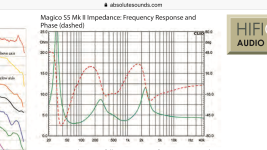I became more and more and more intrgued whith the 5.1s behavior, as a whole, when I saw the graph posted by Melbguy1. The imp and phase curves seemed a bit tortured, not in the high freq but in the mid and bass regions. The global impedance is clearly 4 ohms, descending to unquieting figures of 2 and 2,5 in points very demanding of current from the amp. On the other hand, the impedance shown by the Corona tweeter, from some 3ks on, being low (for me, 4 ohms is still a "low" impedance), is almost flat, what are good news (maybe not for all-tube amps). The phase-angle rotation curve is not the very best and bening in the world.
Obviously, the curves show the 5.1 as a bass-refex design (the double peak at 250 and 25 Hz), and as far I don't know if the port fires to the front or the rear, I'm unable to gess how demanding these loudspeakers will be to position them into a normal living room.
Another, and key, thing I don't know is the overall freq response and how well the drivers overlap.
In any case, auditon is always more important than figures and curves, and I haven't had the chance to hear these units in action, so I will take with confidence Dizzie's cinclusions.
Enviado desde mi LG-E430 mediante Tapatalk


